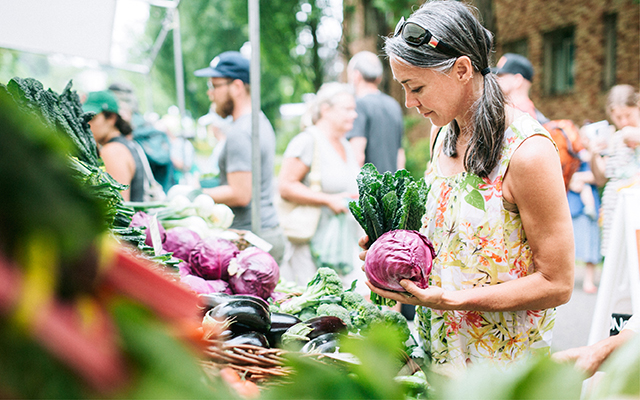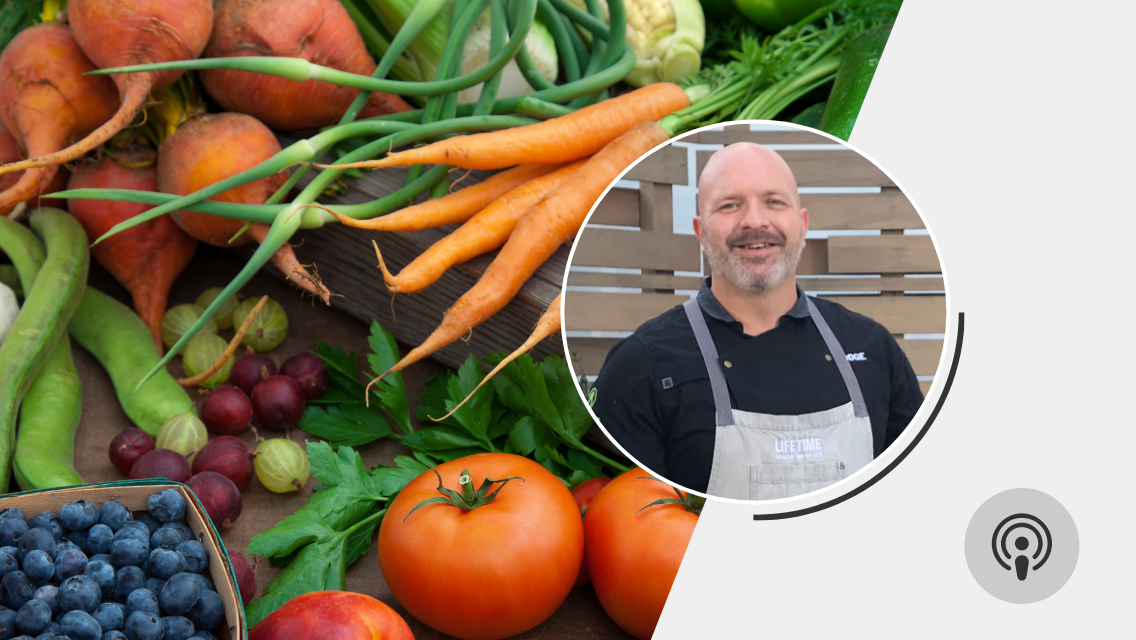Watermelon to help ease the summer heat. Corn-on-the-cob to celebrate Independence Day. Pumpkin seeds roasting in the fall. Eating seasonally is a multisensory delight, from our memories of holiday celebrations to the amazing taste of produce grown and harvested according to nature’s own rhythms.
Beyond the feel-good satisfaction of eating in synch with annual traditions, there are several smart reasons for consuming foods during the harvest windows that nature intended. For one thing, it’s easier to find in-season foods that are locally grown, and enjoying these foods-of-the-moment cuts down on the use of preservatives, fuel and the nutritional-zapping time required for shipping foods from distant regions.
But just as important, in-season foods are more likely to be at their nutritional peak, chock full of the good stuff your body needs for optimum health.
Why Eating With the Seasons Makes Sense
In a modern world where exotic foods are shipped globally and virtually everything is always growing somewhere, what does “in season” really mean?
Generally, the term refers to the kinds of foods that are traditionally harvested and available at the current time of year in your own or nearby growing regions. Some people believe in-season foods provide ingredients that local bodies need at specific times of the year.
Indulging in juicy fruits, such as watermelon and peaches, makes more sense in the summer, when we are hot and sweating more, explains Louella Hill, executive director of Farm Fresh Rhode Island, an organization that connects Rhode Island consumers with local food growers. In the chill of late fall and winter, she explains, we instinctively crave the warmth, comfort and energy density of cooked starchy vegetables, such as potatoes, winter squashes, dried beans, peas and lentils.
In Italy, almost all cooking is done with seasonal produce, and many Italian cooks disdain out-of-season produce that has been shipped long distances. (If you want proof that seasonal foods are more flavorful, consider a trip to Tuscany this autumn and spend a week eating freshly harvested wild mushrooms and tasting the first fall pressings of olives and grapes.)
Unfortunately, many of us in the United States have comparatively little knowledge about the advantages of seasonal eating — and we may be paying a nutritional price for it.
Time Is Right
The Japanese, whose culture is intricately tied to the changing seasons, refer to the time when a particular fruit or vegetable is at its nutrient-rich peak as its shun. Eating a food at its shun is believed essential for good health. And for good reason.
Japanese researchers report that spinach grown naturally in the fields and harvested in season contains three times more vitamin C than spinach grown by artificial means and harvested off-season. Oranges and grapefruits contain the most vitamin C during their peak harvest season, which, depending on variety, runs from late fall into early spring in the United States.
Whether the nutrient content of other fruits and vegetables have similar in-season and off-season differences has yet to be conclusively studied. What is known, however, is that produce is most nutritious as soon as it’s plucked from the garden. After being harvested, fruit and vegetables begin senescence, the process that causes the membranes of plant cells to deteriorate and to release enzymes that break down vitamins and phytochemicals.
Time, in other words, is the enemy of a plant’s nutrients. And since out-of-season produce has to be shipped to grocery stores from fields hundreds or even thousands of miles away, it follows that it loses nutrition during that time. (For more on the nutritional impacts of produce handling and storage, see “Fresh, Frozen or Canned?”.)
Good refrigeration helps preserve some nutrients, but not for long. Spinach, for example, loses about half its folate after eight days of storage at standard refrigerator temperatures (about 40 degrees F). At warmer temperatures, the loss happens faster (a good reason to store newly bought produce in your refrigerator and to eat it as soon after purchase as possible).
Here’s another reason to stay local: Produce shipped long distances is often picked early and treated with a synthetic solution to delay ripening. Eating nonlocally grown seasonal produce, therefore, may increase your exposure to unwanted chemicals.
Buying local, in-season produce isn’t always possible, however — and fruit and veggies that are in-season someplace else may be your only option for many foods. For example, almost all of the potatoes consumed by Americans come from either Washington or Idaho — quite a trek if you live in Alabama or New York. A 2003 study from the Leopold Center of Sustainable Agriculture at Iowa State University found that while Iowa-grown apples travel just 61 miles from orchard to consumer, apples grown outside the state journey an average of 1,726 miles before they reach a dinner table in the Hawkeye state.
So if you want the freshest, most nutrient-rich produce, check out your locally grown, in-season stuff first. If you limit yourself to buying only local produce, though, you’ll run into another problem: Depending on where you live, you might never be able to enjoy oranges, pineapples, avocados or other foods that require subtropical growing conditions. But you don’t have to cut them from your diet; just strive to purchase nonlocal produce when it’s at its nutritional peak (see “What’s In Season?” in the sidebar below).
Tips for Buying Seasonal Produce
So what’s a consumer who wants to buy seasonal produce to do?
- Shop at farmers’ markets, food co-ops or grocery stores that buy from local growers. Or subscribe to a portion of a local farm’s harvest through a community-supported agriculture (CSA) program that delivers fresh produce to you regularly throughout the growing season (see “Buy Local” in the sidebar below).
- Widen your culinary horizon. Never tasted burdock or mustard greens? Give them a try when they come in season in your area (see chart). A varied diet is a more healthful diet because it provides your body with a wider range of essential nutrients. In addition, eating seasonally can make us more creative cooks. It encourages us to experiment with those exotic-sounding and often weird-looking veggies — like broccoli rabe, celery root (celeriac), kohlrabi and rutabaga — that grow where we live but often get overlooked.
- Experiment also with heirloom fruits and vegetables — those “antique” varieties that your grandparents or great-grandparents prized. Technically, an heirloom is an open-pollinated, nonhybrid plant, capable of reproducing itself exactly from its seed each year. Available at farmers’ markets and food co-ops, and, increasingly, at specialty supermarkets, heirloom plants are usually locally grown and offered only in season; thus, they tend to be rich in nutrients, as well as delicious. Heirloom tomatoes are particularly easy to find since they often have colorful names like Bloody Butcher, Djena Lee’s Golden Girl and Tommy Toe. Their one drawback is their higher price.
- Enjoy nonlocal produce in season. Don’t live in subtropical Florida or Southern California? Don’t worry. You can have your bananas and mangoes — and vitamins, too! Just get into the habit of enjoying them in their peak nutritional season (see “What’s in Season?” sidebar).
Seasonal Tradition
Eating seasonally is not new, of course. “People have been eating with the seasons for ages,” Hill says. “In truth, you can find the essence of that in old cookbooks.”
In earlier eras, recipes always combined ingredients harvested around the same time of year — pies made with rhubarb and strawberries (early summer), for example, and soups made with apples and acorn squash (late fall).
Many of our holiday meals still stress seasonal combinations — corn-on-the-cob and watermelon on the Fourth of July, sweet potatoes and cranberries on Thanksgiving.
In this age when we can buy just about any fresh fruit or vegetable year-round, seasonal eating may seem like a novel concept. But it’s as time-proven and honored a tradition as the seasons themselves.
Eating With the Seasons Produce Guide
Seasonal produce varies from region to region and reaches its nutritional peak at slightly different times. Here’s a general season-by-season guide appropriate for most of the United States.
Vegetables
SPRING: April, May, June
Artichoke, arugula, asparagus, beets, Belgian endive, broccoli, collard greens, cucumbers, dandelion greens, green beans, kale, lettuce, mushrooms, mustard greens, okra, peas, radishes, rhubarb, spinach, summer squash, Swiss chard, tomatoes, watercress
SUMMER: July, August, September
Beets, cauliflower, cucumbers, eggplant, fennel, garlic, green beans, kohlrabi, mushrooms, okra, peppers, sweet potatoes, radishes, rutabagas, scallions, summer squash, sweet corn, Swiss chard, tomatoes, turnips, winter squash
FALL: October, November, December
Beets, broccoli, Brussels sprouts, burdock (gobo), cauliflower, daikon, fennel, garlic greens, collard greens, kale, horseradish, kohlrabi, leeks, mushrooms, parsley, parsnips, pumpkins, rutabaga, shallots, sweet potatoes, turnips, winter squash
WINTER: January, February, March
Artichoke, asparagus, beet greens, burdock (gobo), daikon, fennel, garlic, horseradish, kale, leeks, mushrooms, parsnips, potatoes, radicchio, rutabagas, shallots, spinach, turnips, winter squash
YEAR-ROUND
Bok choy, cabbage, carrots, celery, celeriac, lettuce, most onions, peppers, white potatoes
Fruits
SPRING: April, May, June
Apples, apricots, blueberries, cantaloupe, cherries, cranberries, grapefruit, grapes, honeydew, kiwi, limes, mangoes, nectarines, oranges, peaches, pears, pineapples, strawberries, raspberries, watermelon
SUMMER: July, August, September
Apples, apricots, blackberries, blueberries, cantaloupe, cherries, coconuts, cranberries, figs, grapes, honeydew, kiwi, limes, mangoes, nectarines, peaches, pears, pineapples, plums, pomegranates, raspberries, strawberries, watermelon
FALL: October, November, December
Apples, Asian pears, coconuts, cranberries, grapes, grapefruit, honeydew, limes, oranges, pears, persimmons, pomegranates, quince, raspberries, tangerines
WINTER: January, February, March
Apples, coconuts, cranberries, grapefruit, honeydew, mangoes, oranges, papayas, pears, persimmons, pineapples, tangerines
YEAR-ROUND
Avocados, bananas, lemons
How to Buy Local Foods
When it comes to produce, seasonal does not always mean local, but local always means seasonal. Local, in-season produce travels fewer “food miles” and contributes less to carbon dioxide pollution and global warming. Buying local also supports local farmers, invigorates small-farm rural economies and, some studies have shown, helps keep taxes down! Your best bet for buying in-season fruits and vegetables is to search out locally grown food.
Here are some ways to do that:
SHOP AT FARMERS’ MARKETS. Buying directly from local farmers is a surefire way to get fresh, nutrient-packed seasonal produce. To find a market close to you, search the U.S. Department of Agriculture’s list at www.ams.usda.gov/farmersmarkets/map.htm.
JOIN A COMMUNITY-SUPPORTED AGRICULTURE (CSA) GROUP. As part of a CSA, you buy shares in a season’s harvest of a farm in your area. At weekly or other scheduled times during the growing season, you receive a box of in-season produce (which may also include eggs, milk, flowers or other farm products). Most CSAs deliver the food to a central location where members can collect it. To find a CSA farm near you, go to www.localharvest.org/csa.
PICK YOUR OWN PRODUCE. Many local farms open their fields and orchards directly to consumers. You can pick apples, strawberries, pumpkins and whatever other seasonal produce the farm offers. You can’t get any fresher than that (unless you grow the stuff in your own garden). To find a list of pick-your-own farms in your state, go to www.pickyourown.org.
SHOP AT A FOOD COOPERATIVE (CO-OP). Although food co-ops are member-owned businesses, you don’t have to be a member to shop in one. Food co-ops are committed to supporting local farmers, especially organic ones, so they usually have an excellent selection of fresh, seasonal produce. To find a food co-op near you, go to www.coopdirectory.org/directory.htm.
EAT AT RESTAURANTS THAT ARE COMMITTED TO LOCAL FARMERS. The Chefs Collaborative is a national network of members of the food community who are committed to supporting sustainable cuisine by buying local and seasonal food whenever possible. As a result, their menus tend to showcase in-season produce.
This article originally appeared as “In Season” in the June 2006 issue of Experience Life.




This Post Has 0 Comments